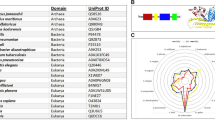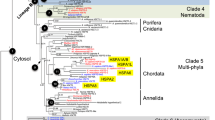Abstract
The co-chaperone Hop [heat shock protein (HSP) organising protein] is known to bind both Hsp70 and Hsp90. Hop comprises three repeats of a tetratricopeptide repeat (TPR) domain, each consisting of three TPR motifs. The first and last TPR domains are followed by a domain containing several dipeptide (DP) repeats called the DP domain. These analyses suggest that the hop genes result from successive recombination events of an ancestral TPR–DP module. From a hydrophobic cluster analysis of homologous Hop protein sequences derived from gene families, we can postulate that shifts in the open reading frames are at the origin of the present sequences. Moreover, these shifts can be related to the presence or absence of biological function. We propose to extend the family of Hop co-chaperons into the kingdom of bacteria, as several structurally related genes have been identified by hydrophobic cluster analysis. We also provide evidence of common structural characteristics between hop and hip genes, suggesting a shared precursor of ancestral TPR–DP domains.



Similar content being viewed by others
Abbreviations
- aa:
-
amino acid
- HCA:
-
hydrophobic cluster analysis
- Hip:
-
Hsp70 interacting protein
- Hop:
-
HSP organizing protein
- HSPs:
-
heat shock proteins
- TPR:
-
tetratricopeptide repeat
References
Altschul SF, Gish W, Miller W, Myers EW, Lipman DJ (1990) Basic local alignment search tool. J Mol Biol 215:403–410
Andrade MA, Perez-Iratxeta C, Ponting CP (2001) Protein repeats: structures, functions, and evolution. J Struct Biol 134:117–131 doi:10.1006/jsbi.2001.4392
Batzer MA, Deininger PL (2002) Alu repeats and human genomic diversity. Nat Rev Genet 5:370–379 doi:10.1038/nrg798
Batzer MA, Deininger PL, Hellmann-Blumberg U, Jurka J, Labuda D, Rubin CM, Schmid CW, Zietkiewicz E, Zuckerkandl E (1996) Standardized nomenclature for Alu repeats. J Mol Evol 42:3–6
Blatch GL, Lässle M (1999) The tetratricopeptide repeat: a structural motif mediating protein–protein interactions. BioEssays 21:932–939 doi:10.1002/(SICI)1521-1878(199911)21:11<932::AID-BIES5>3.0.CO;2-N
Blatch GL, Lässle M, Zetter BR, Kundra V (1997) Isolation of a mouse cDNA encoding mSTI1, a stress-inducible protein containing the TPR motif. Gene 194:277–282 doi:10.1016/S0378-1119(97)00206-0
Callebaut I, Labesse G, Durand P, Poupon A, Canard L, Chomilier J, Henrissat B (1997) Deciphering protein sequence information through Hydrophobic Cluster Analysis (HCA): current status and perspectives. Cell Mol Life Sci 53:621–645 doi:10.1007/s000180050082
Carrello A, Ingley E, Minchin RF, Tsay S, Ratajczak T (1999) The common tetratricopeptide repeat acceptor site for steroid receptor-associated immunophilins and Hop is located in the dimerization domain of Hsp90. J Biol Chem 274:2682–2689 doi:10.1074/jbc.274.5.2682
Carrigan PE, Nelson GM, Roberts PJ, Stoffer J, Riggs DL, Smith DF (2004) Multiple domains of the co-chaperone Hop are important for Hsp70 binding. J Biol Chem 279:16185–16193 doi:10.1074/jbc.M314130200
Carrigan PE, Riggs DL, Chinkers M, Smith DF (2005) Functional comparison of human and Drosophila Hop reveals novel role in steroid receptor maturation. J Biol Chem 280:8906–8911 doi:10.1074/jbc.M414245200
Chen S, Smith DF (1998) Hop as an adaptor in the heat shock protein 70 (Hsp70) and Hsp90 chaperone machinery. J Biol Chem 273:35194–35200 doi:10.1074/jbc.273.52.35194
Chen S, Prapapanich V, Rimerman RA, Honoré B, Smith DF (1996) Interactions of p60, a mediator of progesterone receptor assembly, with heat shock proteins Hsp90 and Hsp70. Mol Endocrinol 10:682–693 doi:10.1210/me.10.6.682
D’Andrea LD, Regan L (2004) TPR proteins: the versatile helix. Trends Biochem Sci 28:655–662 doi:10.1016/j.tibs.2003.10.007
Demand J, Lüders J, Höhfeld J (1998) The carboxy-terminal domain of Hsc70 provides binding sites for a distinct set of chaperone cofactors. Mol Cell Biol 18:2023–2028
Fedorova L, Fedorov A (2003) Introns in gene evolution. Genetica 118:123–131 doi:10.1023/A:1024145407467
Flom G, Weekes J, Williams JJ, Johnson JL (2006) Effect of mutation of the tetratricopeptide repeat and aspartate-proline 2 domains of Sti1 on Hsp90 signaling and interaction in Saccharomyces cerevisiae. Genetics 172:41–51 doi:10.1534/genetics.105.045815
Flom G, Behal RH, Rosen L, Cole DG, Johnson JL (2007) Definition of the minimal fragments of Sti1 required for dimerization, interaction with Hsp70 and Hsp90 and in vivo functions. Biochem J 404:159–167 doi:10.1042/BJ20070084
Gross M, Hessefort S (1992) Purification and characterization of a 66-kDa protein from rabbit reticulocyte lysate which promotes the recycling of Hsp70. J Biol Chem 271:16833–16841
Honoré B, Leffers H, Madsen P, Rasmussen HH, Vandekerckhove J, Celis JE (1992) Molecular cloning and expression of a transformation-sensitive human protein containing the TPR motif and sharing identity to the stress-inducible yeast protein STI1. J Biol Chem 267:8485–8491
Irmer H, Höhfeld J (1997) Characterization of functional domains of the eukaryotic co-chaperone Hip. J Biol Chem 272:2230–2235 doi:10.1074/jbc.272.4.2230
Kimmins S, MacRae TH (2000) Maturation of steroid receptors: an example of functional cooperation among molecular chaperones and their associated proteins. Cell Stress Chaperon 5:76–86 doi:10.1379/1466-1268(2000)005<0076:MOSRAE>2.0.CO;2
Liu FH, Wu SJ, Hu SM, Hsiao CD, Wang C (1999) Specific interaction of the 70-kDa heat shock cognate protein with the tetratricopeptide repeats. J Biol Chem 274:34425–34432 doi:10.1074/jbc.274.48.34425
Long M (2001) Evolution of novel genes. Curr Opin Genet Dev 11:673–680 doi:10.1016/S0959-437X(00)00252-5
Long M, Souza SJ, Gilbert W (1995) Evolution of the intron-exon structure of eukaryotic genes. Curr Opin Genet Dev 5:774–778 doi:10.1016/0959-437X(95)80010-3
Main ERG, Xiong Y, Cocco MJ, D’Andrea L, Regan L (2003) Design of stable α-helical arrays from an idealized TPR motif. Structure 11:497–508 doi:10.1016/S0969-2126(03)00076-5
Mizrak SC, Bogerd J, Lopez-casas PP, Párraga M, Del Mazo J, De Rooij DJ (2006) Expression of stress inducible protein 1 (Stip1) in the mouse testis. Mol Reprod Dev 73:1361–1366 doi:10.1002/mrd.20548
Mulder NJ, Apweiler R (2008) The Interpro database and tools for protein domain analysis. Curr Protoc Bioinformatics 21:2.7.1–2.7.18
Nelson GM, Huffman H, Smith DF (2003) Comparison of the carboxy-terminal DP-repeat region in the co-chaperones Hop and Hip. Cell Stress Chaperon 8:125–133 doi:10.1379/1466-1268(2003)008<0125:COTCDR>2.0.CO;2
Nicolet CM, Craig EA (1989) Isolation and characterization of STI1, a stress-inducible gene from Saccharomyces cerevisiae. Mol Cell Biol 9:3638–3646
Odunuga OO, Longshaw VM, Blatch GL (2004) Hop: more than an Hsp70/Hsp90 adaptor protein. BioEssays 26:1058–1068 doi:10.1002/bies.20107
Papandreou N, Kanehisaa M, Chomilier J (1998) Folding of the human protein FKBP. Lattice Monte-Carlo simulations. CR Biol 321:835–843
Papandreou N, Berezovsky IN, Lopes A, Eliopoulos E, Chomilier J (2004) Universal positions in globular proteins. Eur J Biochem 271:4762–4768 doi:10.1111/j.1432-1033.2004.04440.x
Patthy L (1985) Evolution of the proteases of blood coagulation and fibrinolysis by assemble from modules. Cell 41:657–663 doi:10.1016/S0092-8674(85)80046-5
Patthy L (1987) Intron-dependent evolution: preferred types of exons and introns. FEBS lett 214:1–7
Patthy L (1999) Genome evolution and the evolution of exon-shuffling––a review. Gene 238:103–114 doi:10.1016/S0378-1119(99)00228-0
Patthy L (2003) Modular assembly of genes and the evolution of new functions. Genetica 118:217–231 doi:10.1023/A:1024182432483
Rhee Y, Beavis W, Berardini TZ et al (2003) The Arabidopsis Information Resource (TAIR): a model organism database providing a centralized, curated gateway to Arabidopsis biology, research materials and community. Nucleic Acids Res 31:224–228 doi:10.1093/nar/gkg076
Scheufler C, Brinker A, Bourenkov G, Pegoraro S, Moroder L, Bartunik H, Hartl FU, Moarefi I (2000) Structure of TPR domain-peptide complexes: critical elements in the assembly of the Hsp70-Hsp90 multichaperone machine. Cell 101:199–210 doi:10.1016/S0092-8674(00)80830-2
Torres JH, Chatellard P, Stutz E (1995) Isolation and characterization of gmsti, a stress-inducible gene from soybean (Glycine max) coding for a protein belonging to the TPR (tetratricopeptide repeats) family. Plant Mol Biol 27:1221–1226 doi:10.1007/BF00020896
Woodcock S, Mornon J-P, Henrissat B (1992) Detection of secondary structure elements in proteins by Hydrophobic Cluster Analysis. Prot Eng 5:629–635
Zhang Z, Quick MK, Kanelakis KC, Gijzen M, Krishna P (2003) Characterization of a plant homolog of Hop, a co-chaperone of Hsp90. Plant Physiol 131:525–535 doi:10.1104/pp.011940
Acknowledgments
Many thanks are due to Kirsty MacLellan for careful reading of this manuscript. This work has benefited of a grant from ECOS-Nord French and Colombian program (A0502). J.H.T. has been invited as research fellow by CNRS. RPBS bioinformatics resources have been used for this project (http://bioserv.rpbs.univ-paris-diderot.fr/). We also aknowledge the Vicerrectoría de Investigaciones y Extensión of the Universidad Industrial de Santander, by its financial aid. Part of this work is an application of the Protein Folding Fragments project, supported by European Union, under the grant number QLG2-CT-2002-01298.
Author information
Authors and Affiliations
Corresponding author
Electronic supplementary material
Below is the link to the electronic supplementary material.
Supplementary material
Multiple alignment of TPR–DP domains (top and bottom boxes, respectively) for H. sapiens (Hs), G. max (Gm) and T. cruzi (Tc). To help to recover, the names are as follows: Hs_TPR1 and Hs_DP1 (Hs_TPR2B and Hs_DP2) are TPR1 (TPR2B) from Fig. 3. Gm_DP1 is GMSTI-rf1 and Tc_DP2 is TcHop2-rf1 from Fig. 1. Identical nonhydrophobic residues are colored in blue, and hydrophobic residues identical in at least five sequences (four in the case of DP domains) are colored in green. Stars under the alignment indicate positions only occupied by hydrophobic amino acids. Prolines involved in DP dipeptides are red, and they are also in italic when they are mutated in G. max. In black, the residues mutated by frameshifts (GIF 222 kb)
Rights and permissions
About this article
Cite this article
Hernández Torres, J., Papandreou, N. & Chomilier, J. Sequence analyses reveal that a TPR–DP module, surrounded by recombinable flanking introns, could be at the origin of eukaryotic Hop and Hip TPR–DP domains and prokaryotic GerD proteins. Cell Stress and Chaperones 14, 281–289 (2009). https://doi.org/10.1007/s12192-008-0083-8
Received:
Accepted:
Published:
Issue Date:
DOI: https://doi.org/10.1007/s12192-008-0083-8




